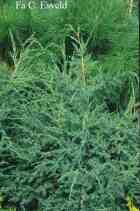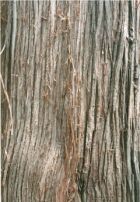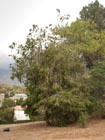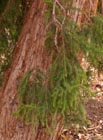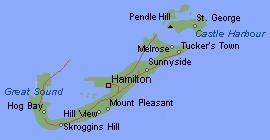Juniperus bermudiana
Linnaeus 1753, p. 1039
Common names
Bermuda cedar, Bermuda juniper.
Taxonomic notes
Syn.: J. oppositifolia Moench 1794, J. pyramidalis Salisb. 1796, Sabina bermudiana (L.) Antoine 1857, J. virginiana var. bermudiana (L.) Vasey 1876 (Farjon 1998).
Description
Tree to 15 m tall. Bark thin, exfoliating in strips. Leafy branchlets 2-4 cm long and 1.3-1.6 mm wide, with a branching angle of 30-35°. Scale leaves opposite, so branchlets are 4-sided, leaves overlapping by 0.4-0.5 times their length, green, decurrent on young plants and on rapidly growing shoots but otherwise scale-like, about 1 mm long, tips obtuse to acute, rounded on the back and tightly appressed. Glands on scale leaves inconspicuous, elongated, sunken, extending almost to the leaf tip. Seed cones dark blue with a bloom, subglobose to reniform, 4-5 mm long, 6-8 mm wide, 1-2(-3) seeds per cone (Adams 1995).
Distribution and Ecology
Bermuda Island (approx. 32°20' N, 64°45' W) (Adams 1995) in temperate, lowland, open forest. Populations occur on limestone-derived soils on hillsides. Naturalized on St. Helena (Anonymous [no date]).
Zone 9 (cold hardiness limit between -6.6°C and -1.1°C) (Bannister and Neuner 2001).
"Currently, some ten percent of the [Bermuda subtropical conifer forest] area is covered by forest or woodland (Procter and Fleming 1999). Within this, only very small and fragmented areas of natural habitat survive. An estimated 95 percent of the surviving population of native Bermuda cedar (Juniperus bermudiana) was destroyed between 1946 and 1951 (Rueger and von Wallmenich 1996) ... Subsequent reforestation using a scale-resistant strain has returned the cedar to roughly ten percent of its former abundance (Procter and Fleming 1999), though these efforts have been hampered by the introduction of fast-growing casuarinas and other exotics into much of the cedar habitat (Sterrer 1995)" (WWF 2001). Bermuda limited the uses of native cedar as early as 1622 (Rueger and von Wallmenich 1996). A well-managed protected areas system currently exists, comprising 12 nature reserves that cover some 48 hectares, as well as 63 parks (Procter and Fleming 1999). The 25-acre Paget Marsh Nature Reserve is the best surviving example of native cedar, palmetto, and mangrove forests (WWF 2001).
The species is critically endangered in habitat due to defoliation and mortality caused by two scale insects, Lepidosaphes newsteadi and Carulaspis minima, that were introduced frrom the mainland U.S. sometime prior to 1942. In 1955 it was estimated that 90% of the trees had been killed; by 1978, the number was 99% (Adams 1995). Genetic diversity of the species was also threatened by hybridization with introduced Juniperus virginiana (Adams and Wingate 2008). The population has begun to recover; the surviving trees are resistant to the scale insect, and both reforestation and natural regeneration have augmented the number and distribution of trees; the population trend is currently (2011) increasing (Wingate et al. 2011).
Authors of the latest conservation assessment report that "Ironically, the Bermuda juniper does best today in that approximate one third of the landscape that is maintained largely free of invasive plants in parks and gardens with extensive lawn areas. Most old pure strain junipers that survived the great scale epidemic are found in cemeteries, parks and private gardens where it is now very much in vogue again to plant cedars because they are more hurricane resistant" (Wingate et al. 2011).
Remarkable Specimens
The Royal Botanical Garden Sydney has several large trees (David Bidwell email 2013.02.18, trees measured the same day). The largest is 15.0 m tall and 136 cm dbh with a 20 m crown spread, and the tallest is 20.0 m tall and 96 cm dbh with a 15 m crown spread. An ornamental specimen in Dove-Myer Robinson Park, Auckland, New Zealand measured 96 cm dbh and 18.0 m tall with a 16.5 m crown spread in 2013 (New Zealand Notable Trees AR/1070, 2013.02.16). I have seen no data on trees in habitat.
Ethnobotany
Formerly (mostly the 16th to mid-20th centuries) it was felled for housing, shipbuilding, furniture, and export (Rueger and von Wallmenich 1996).
It is a moderately common ornamental tree in warm-temperate and subtropical climates.
Observations
The 25-acre Paget Marsh Nature Reserve is the best surviving example of native cedar, palmetto, and mangrove forests (WWF 2001).
Remarks
The epithet refers to Bermuda, where the species occurs.
Citations
Adams, Robert P. 1995. Revisionary study of Caribbean species of Juniperus (Cupressaceae). Phytologia 78: 134-150.
Adams, R. and D. Wingate. 2008. Hybridization between Juniperus bermudiana and J. virginiana in Bermuda. Phytologia 90(2):123-133.
Anonymous. [no date]. 2-40.html. http://www.unep-wcmc.org/species/tree_study/americas/2-40.html, accessed 2002.10.14, now defunct.
Procter, D., and L. V. Fleming (eds.). 1999. Biodiversity: the UK Overseas Territories. Peterborough, Joint Nature Conservation Committee.
Rueger, B. F. and T. N. von Wallmenich. 1996. Human impact on the forests of Bermuda: the decline of endemic cedar and palmetto since 1609, recorded in the Holocene pollen record of Devonshire Marsh. Journal of Paleolimnology 16:59-66.
Sterrer, W. 1995. Bermuda's natural history in a nutshell. In Proceedings of the 1st Symposium of "Fauna & Flora of the Atlantic Islands", Funchal-October 1993. Boletim do Museo Municipal do Funchal, Suplemento No. 4.
Wingate, D. B., R. Adams, and M. Gardner. 2011. Juniperus bermudiana. www.iucnredlist.org/details/full/30376/0, accessed 2013.02.22, now defunct.
[WWF] World Wildlife Fund. 2001. Terrestrial Ecoregions -- Bermuda subtropical conifer forests (NA0301). http://www.worldwildlife.org/wildworld/profiles/terrestrial/na/na0301_full.html (2002.10.14).
See also
Adams, R. P. 1983. The junipers (Juniperus; Cupressaceae) of Hispaniola. Moscosoa 2(1): 77-89.
Adams, R.P. 2008. Juniperus bermudiana: a species in crisis, should it be rescued from introduced Junipers? Phytologia 90(2):134-136.
[BAMZ] Bermuda Aquarium, Museum & Zoo. 1997. Bermuda Biodiversity Project. www.bamz.org/biodiversity/cahow.htm, accessed 1998, now defunct.
Bennett, F.D. and I.W. Hughes. 1959. Biological control of insect pests in Bermuda. Bulletin of Entomology Research 50: 423-436.
Challinor, D. and D. Wingate. 1971. The struggle for the survivial of the Bermudan cedar. Biological Conservation 3(3):220-222.
Elwes and Henry 1906-1913 at the Biodiversity Heritage Library. This series of volumes, privately printed, provides some of the most engaging descriptions of conifers ever published. Although they only treat species cultivated in the U.K. and Ireland, and the taxonomy is a bit dated, still these accounts are thorough, treating such topics as species description, range, varieties, exceptionally old or tall specimens, remarkable trees, and cultivation. Despite being over a century old, they are generally accurate, and are illustrated with some remarkable photographs and lithographs.
FAO Forestry Department. 1986. Databook on endangered tree and shrub species and their provenances. Rome: FAO. 524pp.
Farjon (2005) provides a detailed account, with illustrations.
Groves, G.R. 1955. The Bermuda cedar. World Crops 7:1-5.
Threatened Conifers of the World.
Wingate, D. 2008. Point of view: Conservation of the Bermuda juniper. Phytologia 90(2):137.
